Related Research Articles
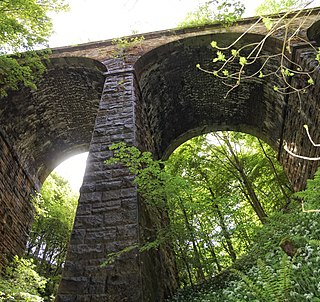
The Beeching cuts was a plan to increase the efficiency of the nationalised railway system in Great Britain. The plan was outlined in two reports: The Reshaping of British Railways (1963) and The Development of the Major Railway Trunk Routes (1965), written by Richard Beeching and published by the British Railways Board.

Greenfield railway station in the village of Greenfield, Greater Manchester, England, is on the Huddersfield Line 12 miles (20 km) northeast of Manchester Victoria. It is the final station in Greater Manchester before the West Yorkshire boundary.
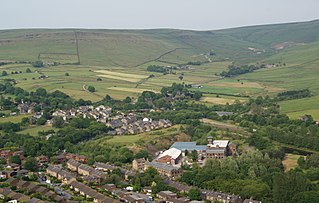
Diggle is a village in the civil parish of the Saddleworth in Metropolitan Borough of Oldham, in Greater Manchester, England. The village is situated on the moorlands of the Pennine hills.

Whitby West Cliff railway station was a railway station on the Whitby Redcar and Middlesbrough Union Railway. It was opened on 3 December 1883, to serve the West Cliff area of the town of Whitby, North Yorkshire, England. It was one of two stations serving Whitby; the other was Whitby Town railway station, which served the lines to Malton and Battersby.
The Cuckoo Line is an informal name for the now defunct railway service which linked Polegate and Eridge in East Sussex, England, from 1880 to 1968. It was nicknamed the Cuckoo Line by drivers, from a tradition observed at the annual fair at Heathfield, a station on the route. At the fair, which was held each April, a lady would release a cuckoo from a basket, it being supposedly the 'first cuckoo of spring'. The railway line served the following Sussex communities: Polegate, Hailsham, Hellingly, Horam for Waldron, Heathfield, Mayfield, Rotherfield and Eridge. Services continued through Eridge and onward via Groombridge to Tunbridge Wells.

Bridport railway station formerly served the town of Bridport in the English county of Dorset. The station was on the Maiden Newton-Bridport branch line; the station opened in 1857 and was closed by British Rail in 1975.
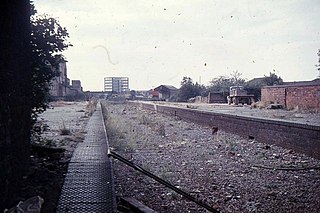
Fishponds railway station was a station in Fishponds, Bristol, England, a victim of Dr Beeching's cuts in the 1960s.
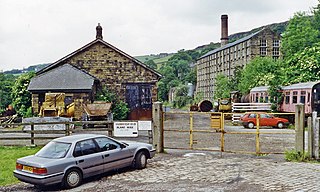
Delph railway station served the village of Delph, Oldham, in what is now Greater Manchester, United Kingdom, between 1851 and 1955.

Haughley railway station was located in Haughley, Suffolk on the Great Eastern Main Line between Liverpool Street Station and Norwich. It opened on 7 July 1849 named Haughley Junction and was a replacement for a station named Haughley Road which had been in service from 1846 to 1849 at location TM 02981 63319 on the line to Elmswell.

Diggle railway station was a station that served the village of Diggle on the Huddersfield Line to the north of Uppermill. Immediately to the west of the Standedge tunnels, it was opened in 1849 along with the first rail tunnel and closed to passenger traffic in 1968. In its heyday, the station had platforms serving all four lines but little trace remains of it today—all of the buildings and much of platforms having been demolished.

Portishead railway station was opened by the Bristol and Portishead Pier and Railway in 1867; it was approximately 0.5 miles (0.80 km) from the village of Portishead. After the opening of the Pier in 1870, the line was extended with an additional railway station opened by the pier. The Pier station closed first; and the original Portishead station closed in 1954, with a new Portishead station opened nearer the town. The 1954 station closed in 1964 when passenger services were withdrawn from the line.
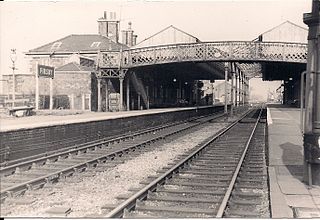
Firsby railway station was a station in Firsby, Lincolnshire. It served as a main line station and a terminus for two branch lines to Skegness and Spilsby respectively. The station was popular in the 19th and early 20th centuries for seaside connections to Skegness, but was recommended for closure in the Beeching Report and closed in 1970. The station was mostly demolished.
The Micklehurst Line was a railway line between Stalybridge, Cheshire, and Diggle junction in the West Riding of Yorkshire. The line, approximately eight miles (13 km) long, was also sometimes referred to as the Micklehurst Loop and the Stalybridge and Diggle Loop Line.

Carno is a closed railway station in Carno, on the Cambrian Line, that was part of the Newtown and Machynlleth Railway. The station was closed in 1965 as part of the Beeching Cuts though there are proposals to re-open it.
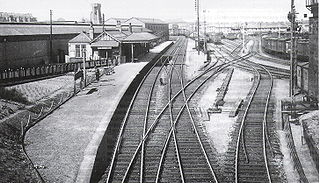
There have been three Kittybrewster railway stations at Kittybrewster, Aberdeen. The first opened in 1854 as a terminus of the Great North of Scotland Railway's (GNoSR) first line to Huntly. This was replaced two years later by a station on a new line to a city terminus at Waterloo. It was replaced again when the Denburn Valley Line to Aberdeen Joint opened in 1867.

Spey Bay railway station was a railway station in Spey Bay, Moray. The railway station was opened by the Great North of Scotland Railway (GNoSR) on its Moray Firth coast line in 1886, served by Aberdeen to Elgin trains. The station was originally named Fochabers-on-Spey railway station on 1 May 1886. In November 1893 it became Fochabers railway station, Fochabers and Spey Bay railway station on 1 January 1916 before finally becoming on 1 January 1918 Spey Bay railway station. It closed to regular passenger traffic on 6 May 1968 on the same date as the line itself.
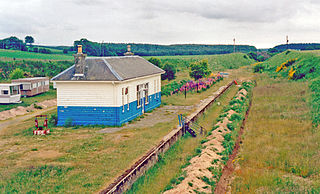
Urquhart railway station was a railway station serving the village of Urquhart, parish of Urquhart, Moray. The railway station was opened by the Great North of Scotland Railway (GNoSR) on its Moray Firth coast line in 1884, served by Aberdeen to Elgin trains.
Calcots railway station was a railway station in the parish of St Andrews-Lhanbryd, Moray. The railway station was opened by the Great North of Scotland Railway (GNoSR) on its Moray Firth coast line in 1884, served by Aberdeen to Elgin trains. It served a rural area rather than a discrete settlement and closed to regular passenger traffic on 6 May 1968 on the same date as the line itself.
Tochieneal railway station was a railway station that served the small industrial village of Tochieneal, close to Cullen in Moray. The railway station was opened by the Great North of Scotland Railway (GNoSR) on its Moray Firth coast line in 1886, served by Aberdeen to Elgin trains. The station closed to regular passenger traffic on 1 October 1951, more than a decade before the total closure of the line itself in 1968.

Glassaugh railway station was a railway station that served the rural area of Glassaugh and the nearby Glenglassaugh distillery close to Portsoy in Moray. The railway station was opened by the Great North of Scotland Railway (GNoSR) on its Moray Firth coast line in 1884, served by Aberdeen to Elgin trains. The station closed to regular passenger traffic on 21 September 1953, more than a decade before the total closure of the line itself in 1968.
References
- 1 2 Butt, R.V.J. (1995). The Directory of Railway Stations. Yeovil: Patrick Stephens Ltd. p. 202. ISBN 1-85260-508-1. R508.
- ↑ Bradbury, Joseph (1871). Saddleworth sketches. Hirst. p. 209.
- ↑ "Anniversary Of When Local Stations Closed". Saddleworth News. 5 October 2010.
- ↑ Denyer, Lucy (26 August 2007). "Right on track - Rural property". The Sunday Times.